Spirea: description, types and varieties, agricultural technology

Spirea is a very beautiful, unpretentious ornamental plant in maintenance. It easily tolerates temperature extremes, is drought tolerant and gets along well with any crop. Thanks to these qualities, spirea is very popular among landscape designers and is actively used by them in landscaping gardens and parks.

Description
Spirea (from the Greek "spiral") is represented by a perennial shrub of the deciduous type of the rose family. It grows on the slopes of the Alps, at the foot of the Himalayas, as well as in the forest and forest-steppe zones of the temperate zone. Thanks to the cascading curving branches and abundant flowering, the plant is actively used for landscaping public spaces. Many inexperienced summer residents often confuse it with meadowsweet - a herb that looks like some varieties of spirea. According to the timing and duration of flowering, three types of spirits are distinguished: spring flowering, summer flowering and late flowering.

Below are considered the general morphological signs of spirea, in one way or another, inherent in all plant species.
- An adult spirea often reaches a height of 2.5 m and is distinguished by a variety of forms. In addition to weeping, pyramidal, erect, hemispherical and cascading bushes, there are creeping species.
- The plant impresses with a variety of shapes and colors of leaves, many of which change their color towards the end of the growing season. Cultivars with yellow, orange, purple and red leaves, which stand out noticeably against the background of other garden vegetation, are especially appreciated.
- Spirea belongs to tree-like shrubs and is covered with longitudinally exfoliating bark. Young branches have a light green, yellowish, reddish or brown tint, can be bare or pubescent.
- The root system of the spirea is of the fibrous type and has a superficial location.
- The buds of most plants are very small, but in some species it can reach 1 cm in length. In their structure, they can be double or single, and in shape - round, ovoid and pointed. Some of them have slight pubescence, and some are completely naked. Both those and others have a scaly structure and consist of 2-8 scales.
- Spirea leaves come in different shapes - from round to narrow-lanceolate. All of them have a petiole, consist of 3-5 lobes, do not have stipules and are arranged alternately.
- Inflorescences of early flowering varieties are represented by sessile (semi-sedentary) umbrellas or corymbose racemes, framed with rosettes of leaves at their bases. The inflorescences of summer-flowering spirae are simple and complex scutes located at the ends of the short branches of the current year. In late-flowering plants, inflorescences are represented by narrow-cylindrical, pyramidal or elliptical panicles located at the tips of long branches of the current season.
- Spirea flowers are often bisexual, although there are also species with dioecious flowers. In spring flowering plants they are almost always white, in summer flowering plants they are white, lilac, pink and red, and in late flowering plants they have a beautiful purple color. In their shape, the flowers are cupped and bell-shaped, have 5 sepals and up to 60 stamens.
- Spirea fruits are represented by multi-seeded leaflets, opening along the inner, and a little later, along the outer seam. The seeds begin to spill out 2 months after flowering, have a flat lanceolate shape, are brown and reach a length of 1.5-2 mm.
- The flowering of spring-flowering species is very friendly, but short, summer ones bloom just as massively and bloom a little longer, and late-flowering bushes bloom gradually, which is why they do not look as impressive as summer and spring species. The plant begins to bloom only 3-4 years after planting, and the first flowering in most varieties is very poor, with a large number of unblown buds.

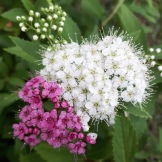
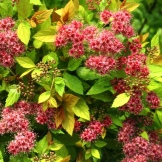
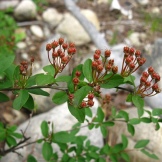
Some varieties of spirea are used as a source of medicinal raw materials. The therapeutic effect is due to the presence of saponins, ascorbic acid, alkaloids, flavonoids, tannins and carotene. Moreover, some species are excellent honey plants.
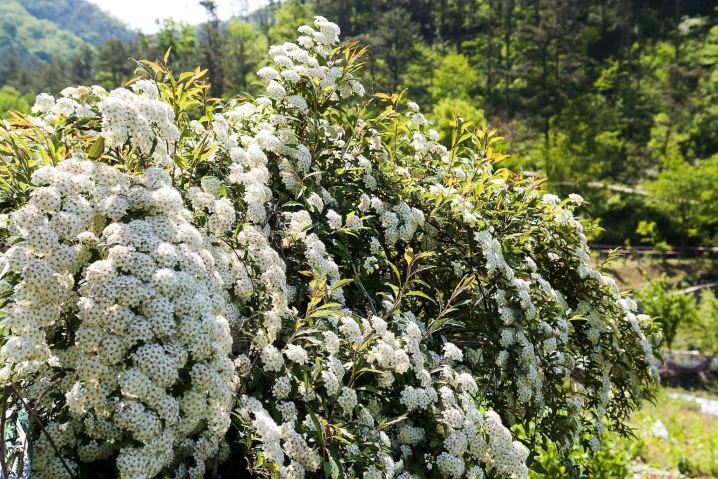
In addition to medicinal and decorative functions, spireas often play the role of soil-strengthening plants and are planted along water bodies and on problem soils. All varieties of this wonderful plant are absolutely undemanding to the soil, frost-resistant, photophilous and feel good in a gas-polluted urban environment. This allows them to be used for landscaping flower beds located along highways in the center of megacities.
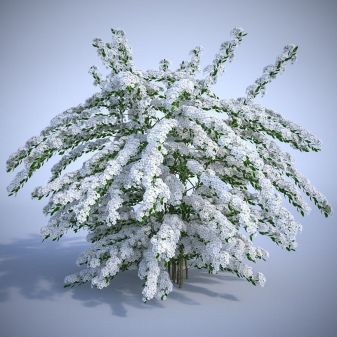
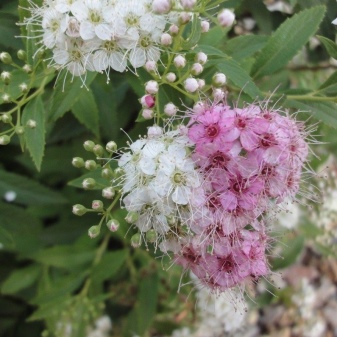
Main types
The genus spirea has about a hundred plant species, conventionally divided into two categories: spring-flowering and summer-flowering. The latter include late flowering plants, which by the end of summer are just beginning to be covered with flowers. Below are some popular types that are most often used in landscaping.
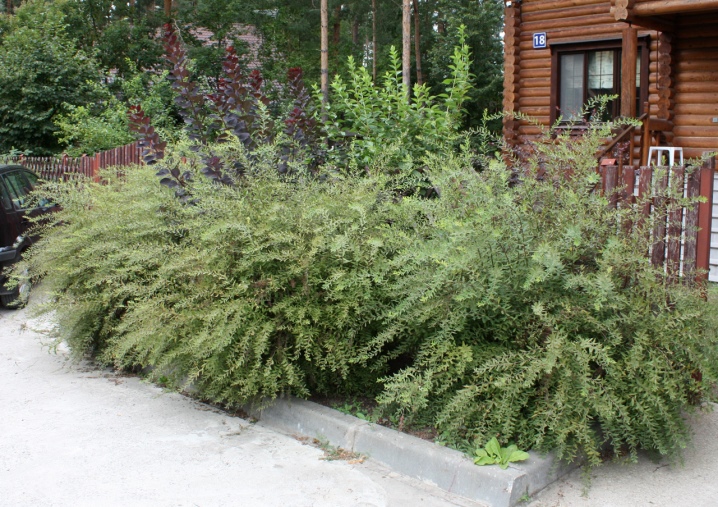
Gray
This species belongs to spring flowering and is represented by bushes of 2 meters in height. The branches of the plant are felt, ribbed, the leaves are pointed, the flowers are white and collected in shields. The plant blooms in May, and after a month bears fruit.
The species belongs to hybrids, so seed reproduction is impossible. In landscape design, it is used both in single plantings and in group compositions and is very appreciated for the huge number of inflorescences that form beautiful snow-white caps on the bush.
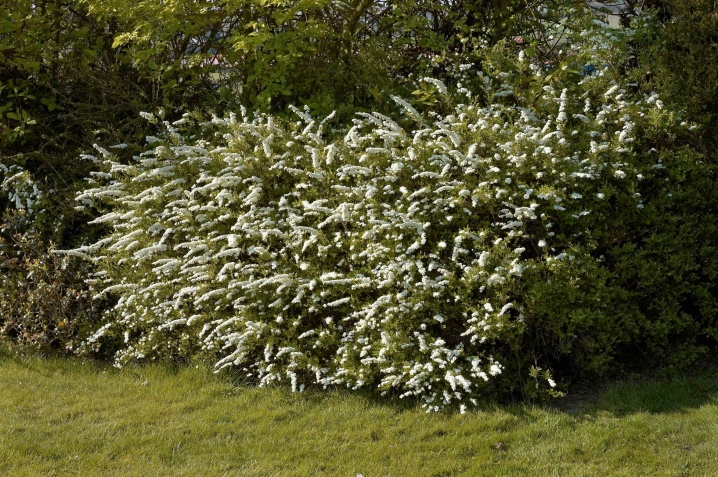
Wangutta
This species is spring-flowering and amazes others with its size. The height of an adult bush reaches 2.5 m. In comparison with other species, the plant blooms for a rather long time. Flowering begins in mid-May and lasts until the end of June. Due to its high growth and spreading, the species is used to create hedges.
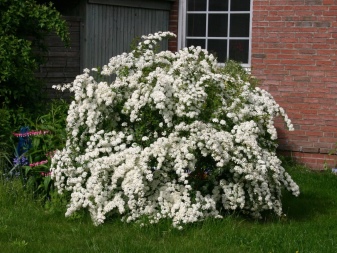
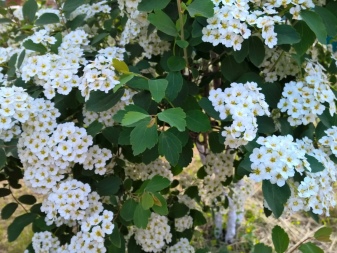
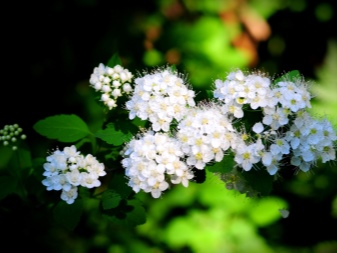
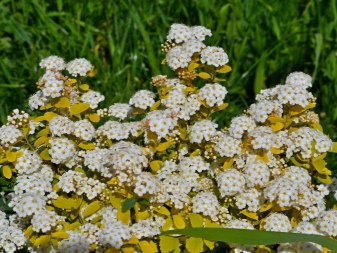
Plants grow well in the sun and in partial shade, undemanding to soil, frost-resistant and able to withstand a short drought. Wangutta looks especially beautiful in combination with blooming viburnum and jasmine, as well as with all types of conifers.
The species is characterized by repeated flowering, which occurs in August. However, it is no longer as abundant as spring and does not occur every year and not in all plants. Wangutta grows very quickly and can be cut well.
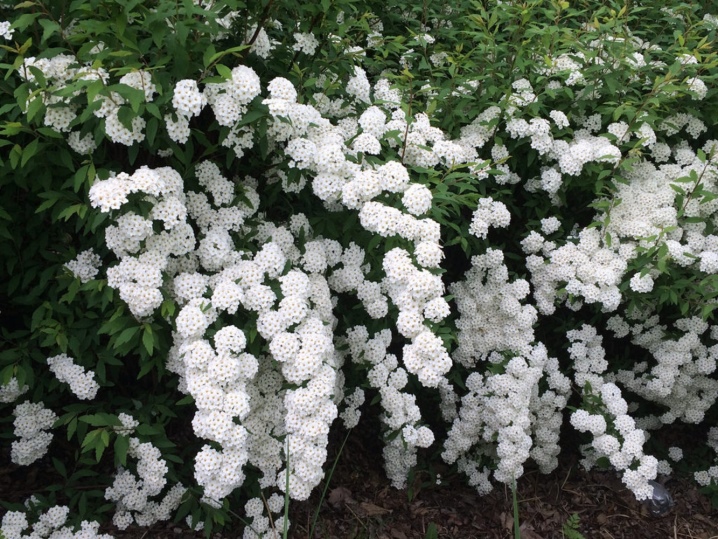
Dubravkolistnaya
Another spring flowering species. It grows throughout the territory of our country: from the Far East to the western regions. Its habitat in its natural environment is rocky slopes and mountain forests. The plant is an upright bush with a height of 2 m. During flowering, which occurs at the beginning of June and lasts 3 weeks, the branches, under the weight of the inflorescences, lean slightly towards the ground.
Spireas of this species tolerate frost well, are able to grow in a gassed space and in partial shade. The bushes are covered with graceful ovoid or oval leaves up to 4.5 cm long.
The look is perfect for creating natural compositions and lends itself well to haircuts.
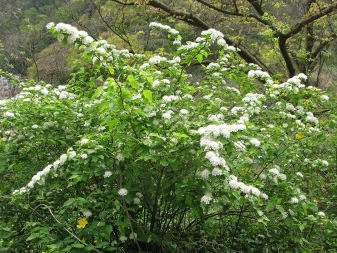
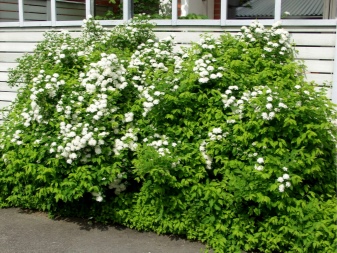
Thunberg
The spring-flowering Thunberg spirea grows on the mountain slopes of China, Japan and Korea. The bushes grow up to 1.5 m and are covered with decorative leaves 4 cm long. Due to the foliage, which turns orange in autumn, the species is very popular with landscape designers and is considered one of the most beautiful.
The plant blooms almost the very first (in mid-May) and is distinguished by the rapid ripening of fruits. The species prefers sunny areas and requires shelter for the winter.
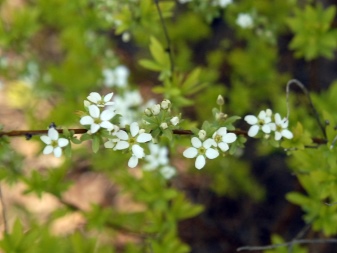
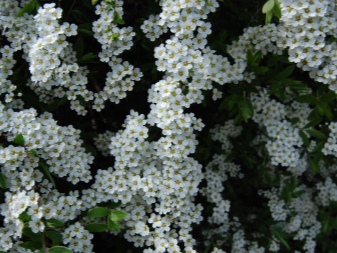
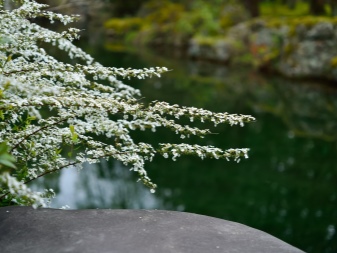
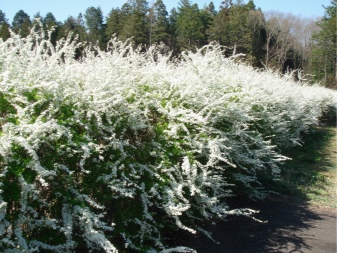
Gorodchaty
Spirea crenate blooms in spring and grows in Russia, Western Europe and Central Asia. Its habitat is meadows, steppes and rocky mountain slopes. The species is considered especially valuable and is protected in protected areas. The growth of the bushes is 1 m, the crown is loose, the leaves are oblong or obovate, gray-green in color.
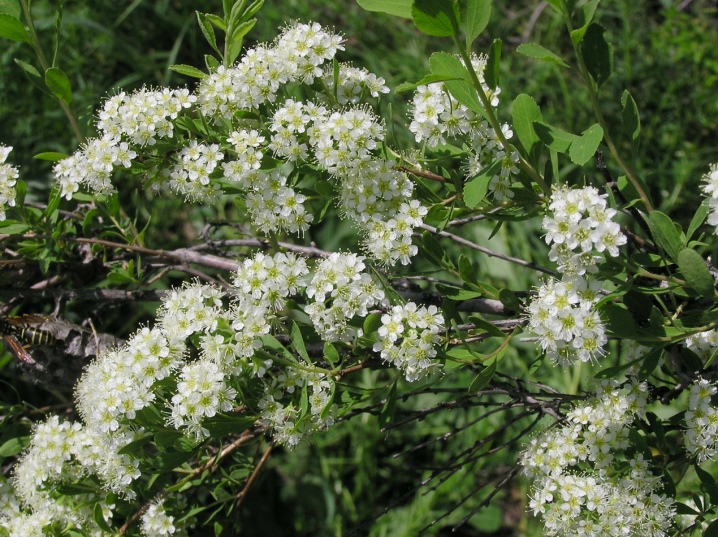
A distinctive feature of the species is the presence of three veins located on the back of the leaf. Flowering begins in early June and lasts 20 days. The species tolerates short drought well, can grow in partial shade and gives numerous root shoots. Due to the fact that the bushes are quite strong and low, the plant is often used to strengthen swelling soils.
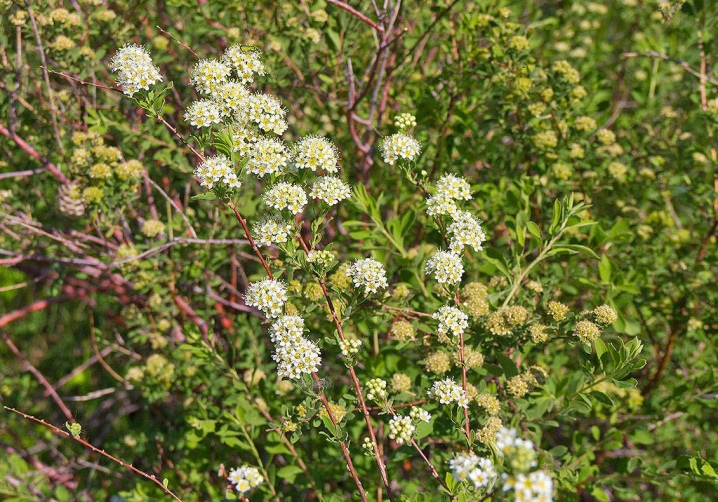
In spring-flowering species, flowers appear on two-year-old shoots, and in summer-flowering species, on the branches of the current year. The latter have a higher decorative effect, which is due to the large number of varieties with red and pink inflorescences. Among the popular summer-flowering species are willow spirea, white-flowered, dense-flowered and Japanese spirea.
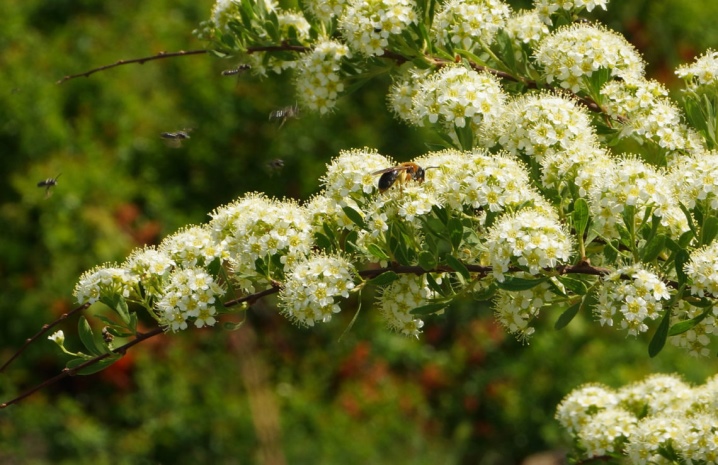
The latter is most widespread, due to the small height of the bushes (about 50 cm) and the long flowering period, which begins in mid-July and lasts almost 2 months. The species looks great in group compositions and borders and has several gold-leafed varieties such as Golden Princesses and Gold Mound.
White-flowered spirea exudes a pleasant persistent aroma during flowering and is distinguished by beautiful white flowers. Spirea willow leaf is known for narrow leaves that acquire a red tint in autumn and spectacular light pink inflorescences. Used in hedges and group plantings. The dense-flowered spirea grows no higher than 80 cm, has reddish stems, green leaves, which turn orange by autumn, and bright pink large inflorescences. The plant blooms a little earlier than Japanese spirea and blooms for 2 months.
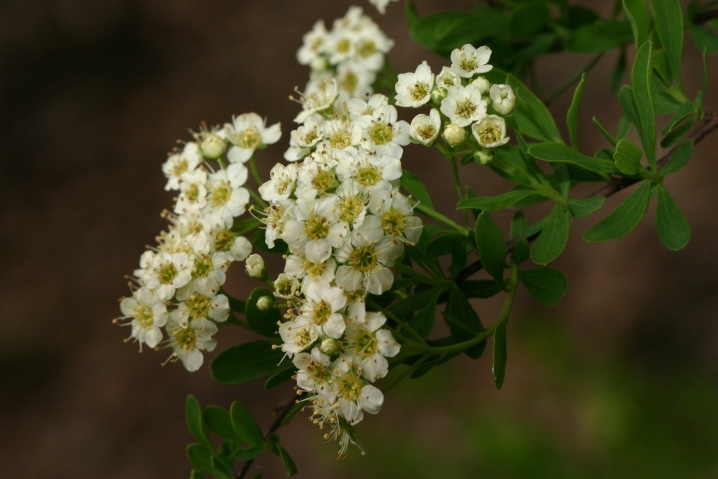
Varieties
Depending on the variety, spireas are characterized by a wide variety of shapes and colors. The most interesting varieties, distinguished by high decorative properties and unpretentiousness, are considered below.
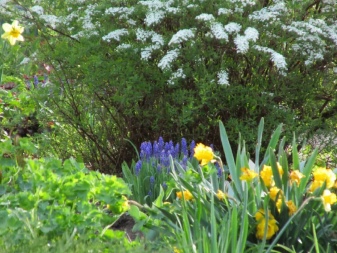
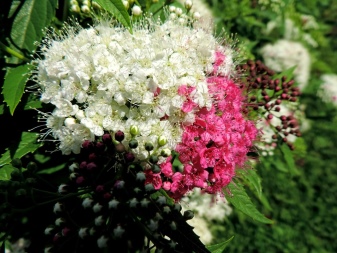
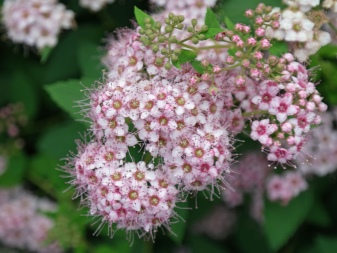
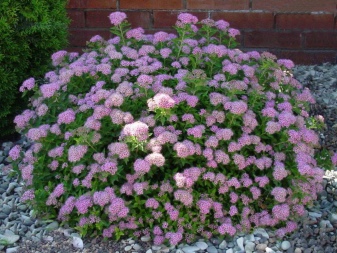
"Grefsheim"
It is a representative of the spring-flowering species of gray spirea and is very interesting from a decorative point of view. It was obtained by crossing St. John's wort and whitish-gray spire. The plant is a small densely branched bush, a distinctive feature of which are arched, as if drooping branches and narrow leaves. Large white double flowers are collected in dense bunches located along each branch.
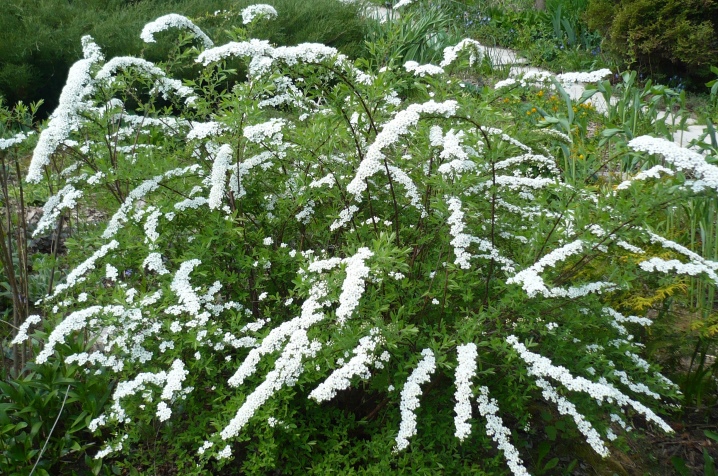
This arrangement gives the bush aesthetics and makes it noticeable against the general background.
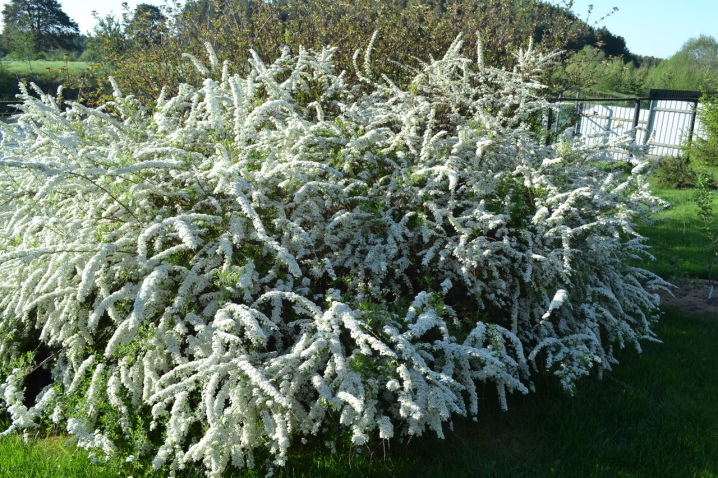
"Anthony Vaterer"
Refers to the summer-flowering species of Bumald's spirea, which is a hybrid of white-flowered spirea and Japanese spirea. The plant is a bush with bright red flowers and beautiful narrow leaves. A characteristic feature of the variety is its long flowering, which lasts about 100 days. The most effective compositions are obtained with panicle hydrangea blooming at exactly the same time.
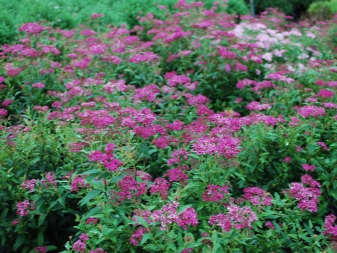
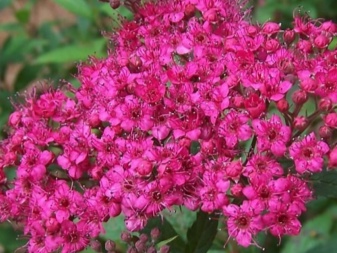
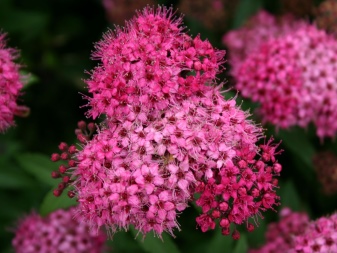
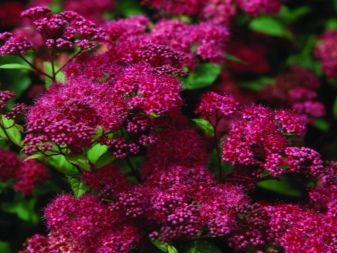
"Shirobana"
It is considered one of the most interesting varieties. It is represented by a low-growing shrub up to 80 cm high with narrow-lanceolate dark green leaves 2 cm long. The bush contains white, pink and red flowers at the same time, which gives it a high decorative effect. The flowering of the bush begins in early July and lasts until the end of August. "Shirobana" is actively used to decorate rock gardens, low borders and ensembles, which include different types of conifers.

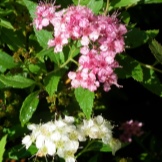
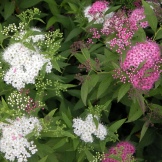
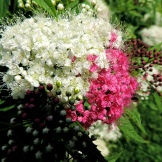
The variety was most widespread in Japan and China, although in our country it is also gaining popularity and wins the hearts of landscape designers.
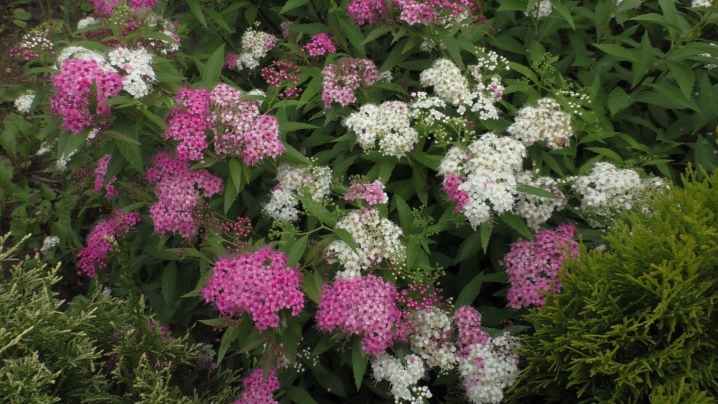
Snowmound
It belongs to the spring-flowering species of Nipponskaya spirea and is a bush with a dense crown and gracefully curved branches 2 m high. The spirea has elongated dark green leaves and blooms with beautiful snow-white flowers, collected in corymbose inflorescences. Flowering begins in June and lasts about three weeks. In the wild, "Snowmound" grows in Japan, on the island of Hondo.
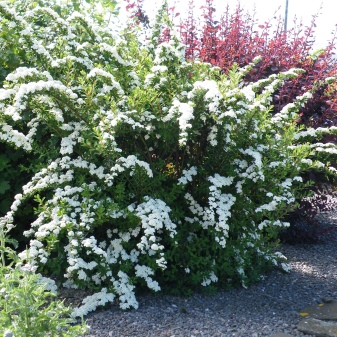

"Sparkling Champagne"
It is a representative of the Japanese spirea species and belongs to summer-flowering plants. The variety is very beautiful and unusual at every stage of the growing season. For example, leaves, which are bright pink in spring, turn bright green by the end of summer. The plant blooms very effectively and profusely, attracting the attention of not only people, but also bees.

The variety is considered a good honey plant and has beautiful and large flowers. The bushes have red stems and grow up to 80 cm. The plant tolerates frost well, can grow in light shade and is undemanding to the composition of the soil. The only thing that needs to be provided for the variety is regular watering. The soil should always be slightly moist and loose.
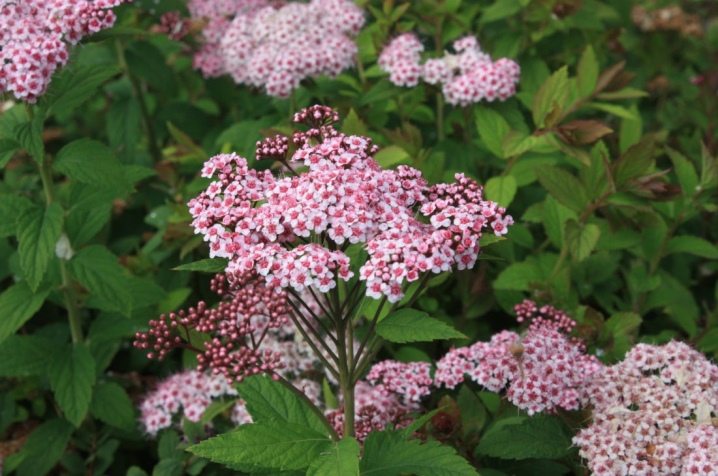
How to grow?
It is quite easy to grow a spirea, the main thing is to choose the right place, follow all the planting rules and provide the plant with proper care. You should also be careful about the choice of seedlings and purchase only strong specimens with healthy roots. For spring planting, you need to choose shoots with dormant buds, and from autumn planting, foliage should completely fall off. If the root shoots are too long, they are lightly trimmed with a sterile knife and cut with charcoal.
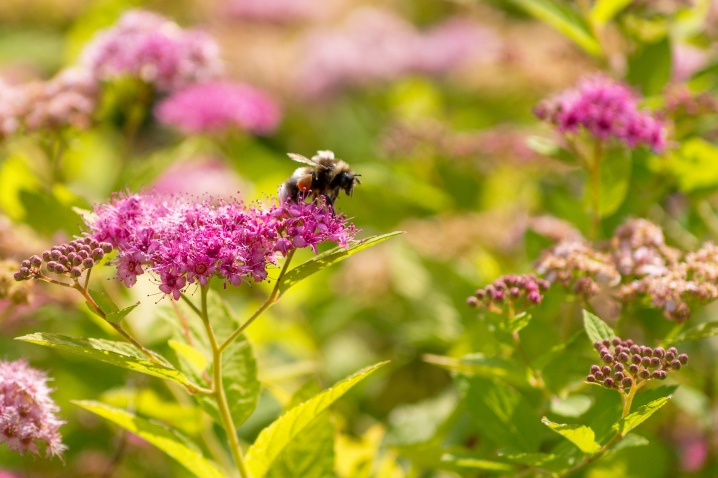
Another important point is the species and varietal characteristics of the seedling. So, for Siberia and the Urals, where the climate is characterized by hot summers and cold winters, frost-resistant species should be chosen, but all varieties take root in the southern regions.
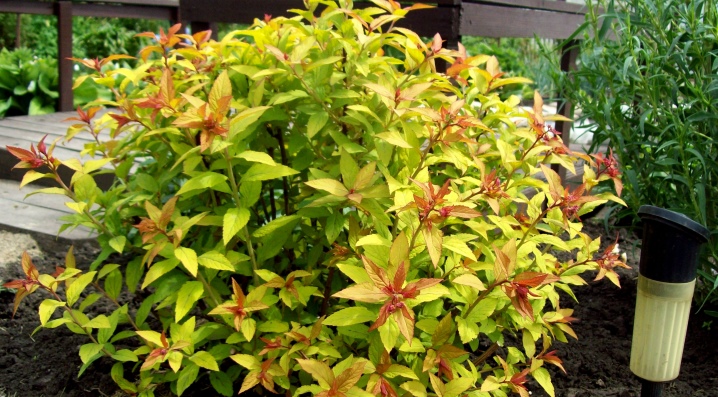
For regions with a cold climate, it is better to take undersized shrubs that can hide under the snow cover and survive the winter without much loss. Tall species in severe frosts can freeze branches, after which you can not expect abundant flowering from them.
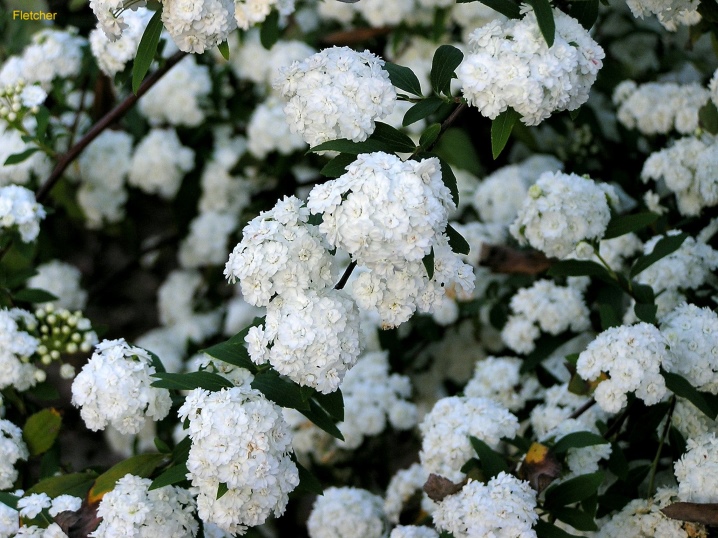
Timing
Spirea is planted in spring and autumn. Early flowering species are recommended to be planted in September, before leaf fall is complete. Frosts have not yet come at this time, so the plant has time to take root and gain strength for wintering. Late flowering species, on the other hand, are best planted in spring, before sap flows and buds awaken. It is better to choose cloudy and not too hot weather for planting spirea.
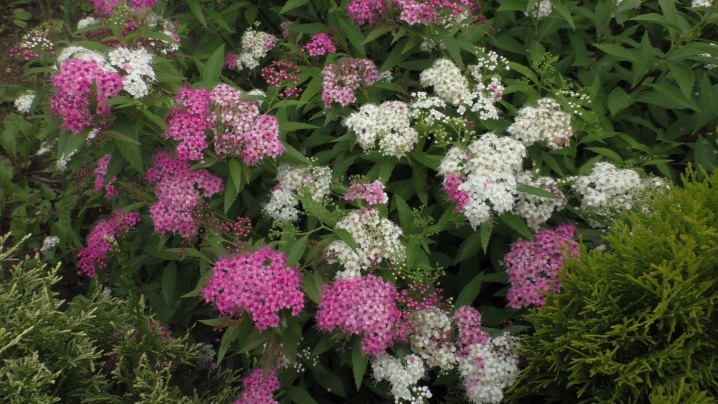
Soil preparation
The soil for the spirea should be loose, slightly moist and breathable. If the soil is very depleted, then turf or leaf humus is added to it, and if the soil in the chosen place is too clayey, then peat and sand are additionally added. When planting hybrid species, it is necessary to ensure that there are no traces of lime in the soil. As for acidity, spirea prefers neutral soils, although it can grow in slightly acidic ones.
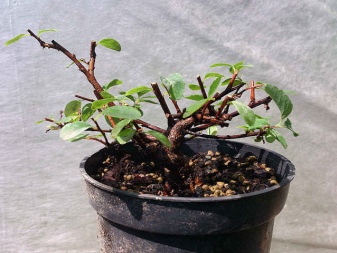

Landing scheme
Landing algorithm spirea is quite simple and includes several stages.
- 2-3 days before planting, holes are dug on the site with a size of 30x30 cm and a depth of 60-70 cm. Between neighboring bushes, a distance of 70 to 100 cm is maintained, and when a hedge is formed, about 30 cm.
- Drainage must be laid at the bottom, as which you can use broken brick, river pebbles or large rubble.
- A layer of coarse sand is poured over the drainage 5 cm thick and poured a nutrient substrate with a slide.
- A seedling is placed on the top of the hill, the roots are carefully straightened and buried to the level of the root collar.
- The earth is carefully tamped and pour 2 buckets of water under the bush.

The soil that has settled from the first watering is poured to the level of the root collar, after which the trunk circle is mulched with peat or needles.
Top dressing
Fertilizers for spirea need to be applied three times per season. For the first time, the plant must be fed immediately after the spring pruning, using nitrogen-containing compounds for this. They will contribute to the active awakening of the kidneys and the rapid growth of green mass.
The second feeding is performed in the summer, using potassium-phosphorus preparations for it. This is especially important for late-flowering species that are just about to bloom. And the third feeding is carried out in the fall, after the spirea has faded. To do this, use any organic fertilizer, including mullein solution.
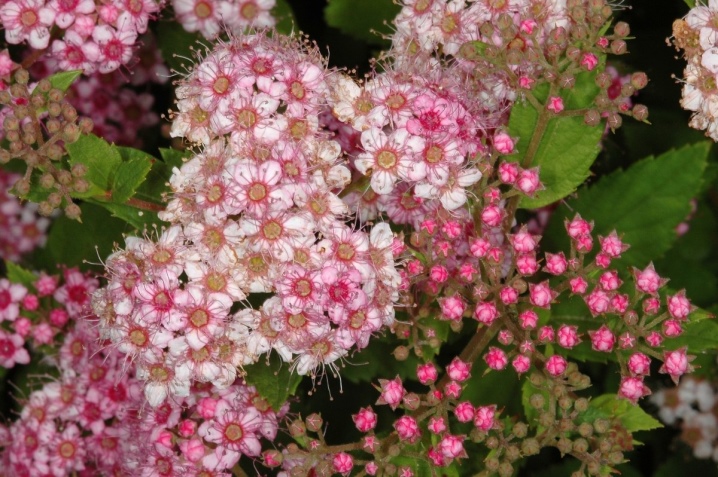
Watering
Spirea, although resistant to short-term drought, requires regular moisture. This is due to the superficial location of the roots, from which moisture quickly goes down. Adult tall bushes need 20 liters of water 2 times a month, and undersized ones need 10-15.

Pruning
Spirea bushes tend to grow rapidly and need regular pruning. In early flowering species, where inflorescences are located along the entire length of the shoots, only the ends of the branches that have frozen over the winter are cut off. Old and damaged branches are removed any day of the growing season. Pruning is done in the spring, before the start of the sap flow of plants.
Once every 7-10 years, it is recommended to rejuvenate the bushes by cutting off all branches at the root. As for the decorative formation of the crown, the protruding shoots are trimmed immediately after flowering, at the same time getting rid of thin, crooked and thickening branches.

Late flowering spireas are also pruned in early spring and done before the first bud. Weak and small branches are removed completely. As for young plants, up to 4 years old, only damaged and frozen shoots, as well as branches that dry out, are removed from them.
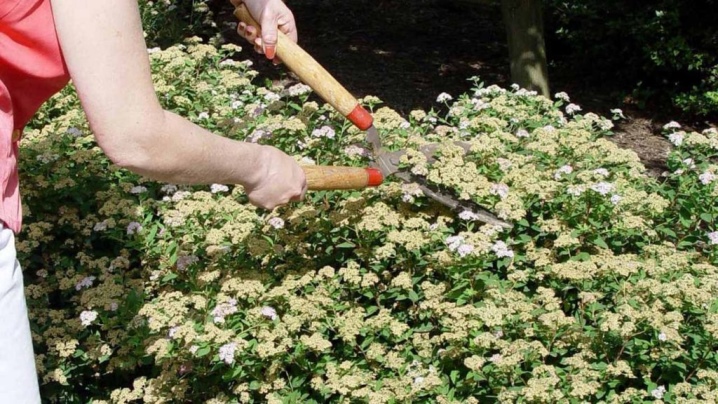
From the age of 4, the bushes are pruned annually, leaving 30 cm from the ground level. The life span of summer flowering species is about 20 years. Low-growing varieties with a height of no more than 50 cm are cut only for 2 buds.

Weeding and loosening
Gardeners advise against hardening of the near-stem soil, which blocks air access to the roots. The land around the bush must be periodically loosened and weeded, taking care not to damage the superficial root system.

What to do after flowering?
After the spirea has faded, faded peduncles are cut off from it, formative pruning is performed and they begin to prepare for winter. Immediately after flowering, it is recommended to fertilize the plant with any organic composition so that it has time to make a supply of nutrients necessary for wintering. After the onset of the first frost, the root zone is covered with dry foliage or humus. The layer thickness varies from 10 to 15 cm, depending on the climatic zone.

In a sharply continental climate with dry frosty winters and a complete absence of snow cover, it is recommended to build a shelter. To do this, you need to tie the branches into a tight bundle, bend them to the ground and fix them in a special frame. From above, the structure is covered with spruce branches or dry leaves, not forgetting to disassemble the shelter at the onset of the first spring thaws.
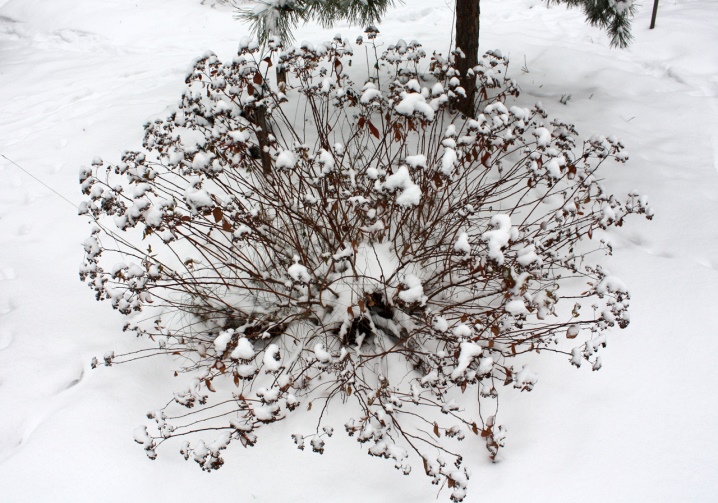
Diseases and pests
Spirea has good immunity and practically does not get sick. The main problem for gardeners when growing it is spider mites, aphids, whiteflies and blue meadow sawfly. They love to feast on fresh young leaves, which cause significant damage to the plant. To prevent the invasion of pests, it is recommended to spray spirea with insecticides, for example, "Aktellik", "Karbofos" or "Fitoverm", and the latter can be used even during the flowering period.
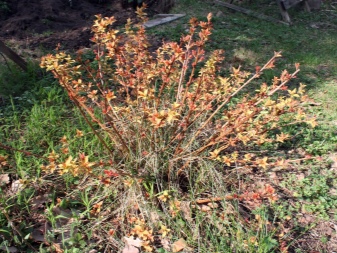
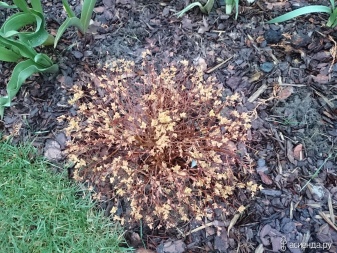

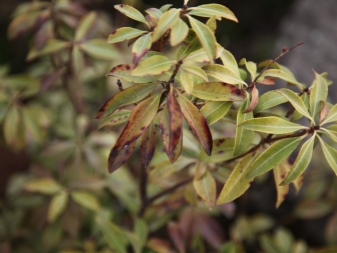
Of the possible diseases, it is worth noting the fungus and root rot, arising from the stagnation of fluid in the root zone. Treatment begins immediately after the detection of the disease and is done with the help of fungicides: "Fundazola", "Fitosporin-M" and "Abiga-Pica".
When rust appears on the bushes, Bordeaux liquid is used. As a prevention of fungal diseases, regular loosening of the soil and an increase in the intervals between waterings help. You can fight growths on the trunks with the help of iron sulfate.

How to propagate?
It is quite simple to breed spirea and it can be done in three ways: by layering, cuttings and growing from seeds. True, the latter method is very time consuming and does not guarantee the preservation of generic characteristics in young spirits.
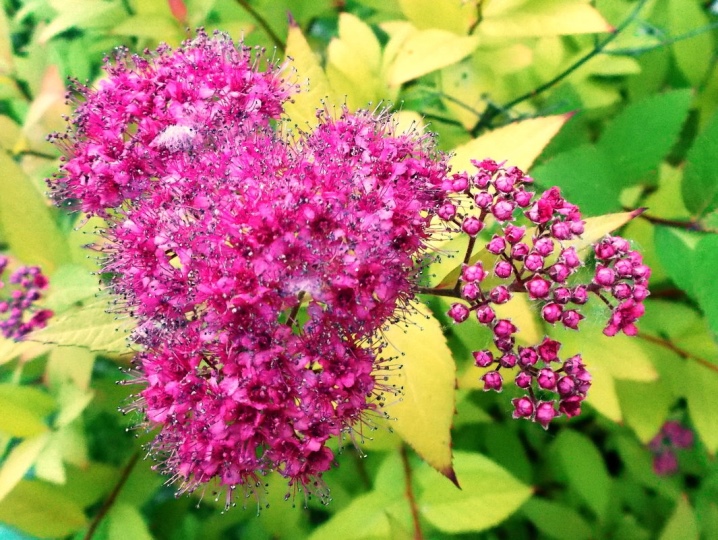
Layers
This method allows you to easily get a healthy generation that fully preserves all the varietal characteristics of the parent. The essence of the method is as follows: an extreme young shoot with leaves is taken from a 3-year-old bush and the top layer of the bark is scraped off in several places. Then a flat, not too deep furrow is dug to the side from the root, the shoot is laid in it and fixed with garden pins.
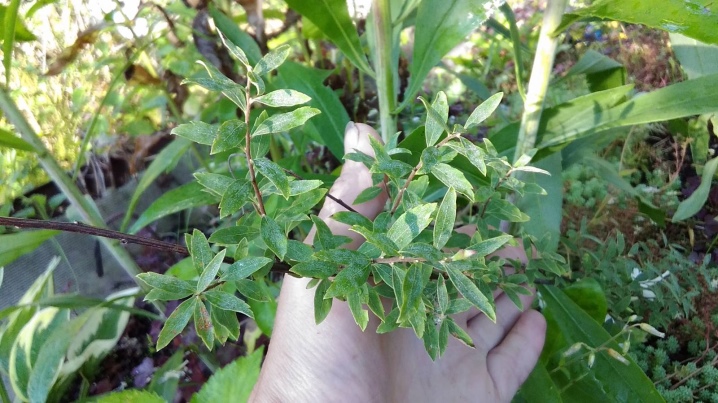
Next, the layers are sprinkled with fertile soil and watered. In the future, when watering the mother bush, be sure to water the groove. If everything is done correctly, then by the fall, shoots will begin to appear from the layer. Young plants are allowed to overwinter with the mother, and in the spring they are separated from the parent bush and transplanted to a permanent place.
Cuttings
Spirea can also be diluted by cuttings. To do this, a strong and young annual shoot is cut from a healthy bush and cut into several parts, making sure that each of them has several leaves. Further the lower leaves are cut off from the cuttings and placed in a solution of "Epin" or "Kornevin" for 12 hours... At this time, a fertile mixture is prepared from garden soil, sand, peat, humus and poured into a wooden box. Then cuttings are planted there and watered well.

Each stalk is covered with a glass jar or an ordinary plastic bottle and removed in partial shade. Throughout the season, the planting is aired and sprayed from a spray bottle 2 times a day. In the fall, the box is dug into the ground, mulched with dry foliage and a shelter is erected in the form of a wooden box. In the spring, the box is removed, they are waiting for the appearance of young shoots, after which the plants are planted in permanent places.
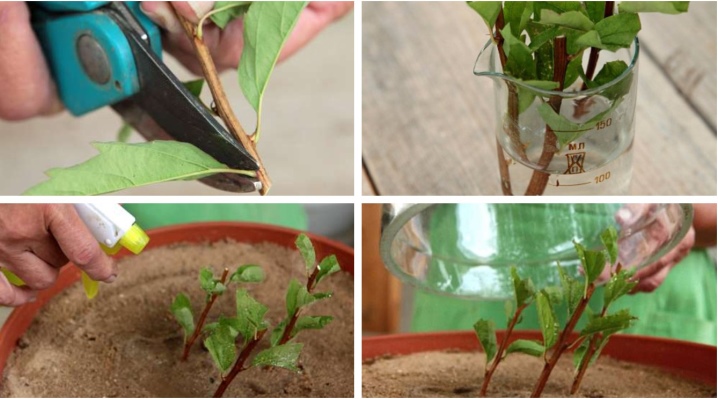
Use in landscape design
Spirea is widely used in landscape design. She looks great both in a single fit and as part of a complex ensemble. Due to the huge varietal variety, the plant is used in rockeries, rock gardens, hedges, for decorating borders and flower beds, in exquisite compositions with the most unusual plants, as well as for strengthening the soil along the banks of water bodies.
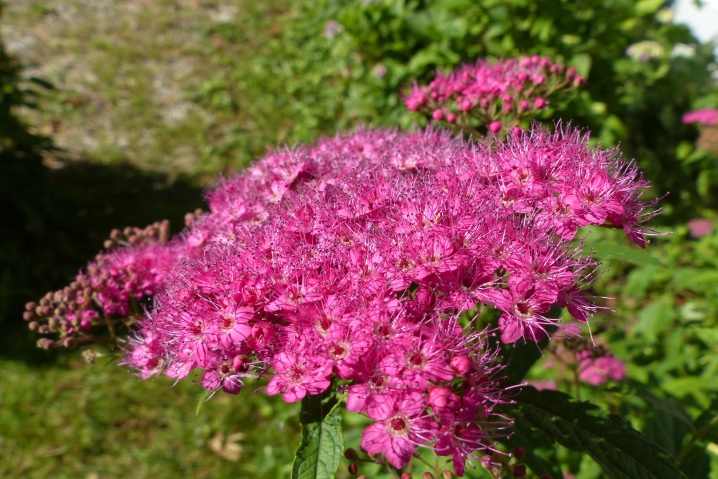
As companions for spirea, they are perfect spruce, weigela, scumpia, action and juniper... Let's consider some interesting examples of the use of spirea in landscape design.
Bicolor spirea in the rock garden.
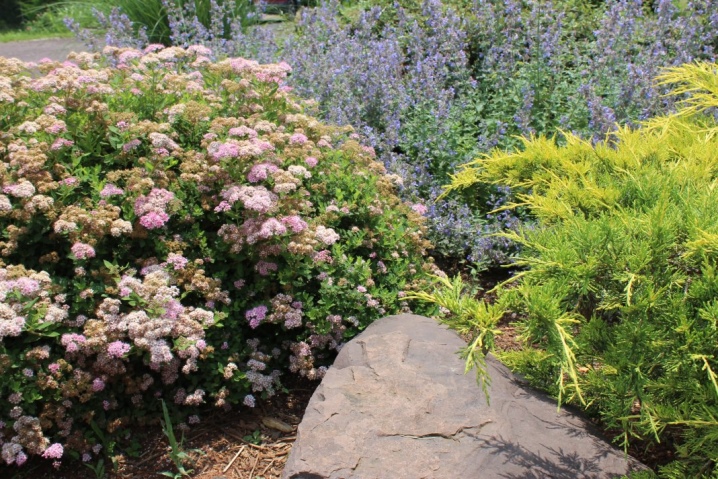
Spirea looks good in the company of conifers.
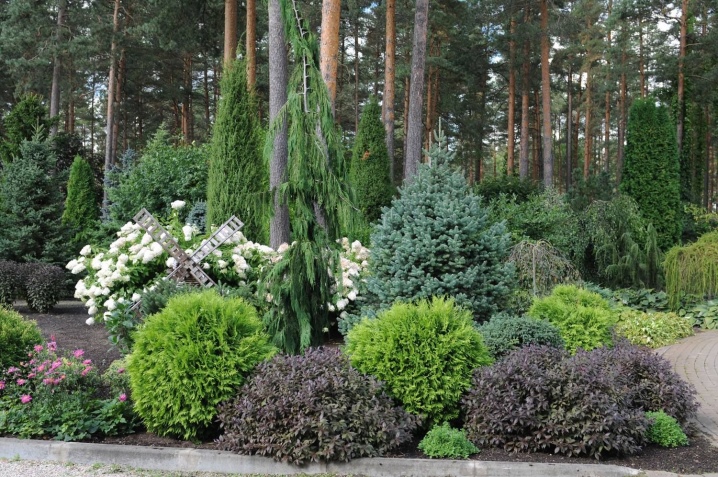
Tall types of spirea are good for creating hedges.
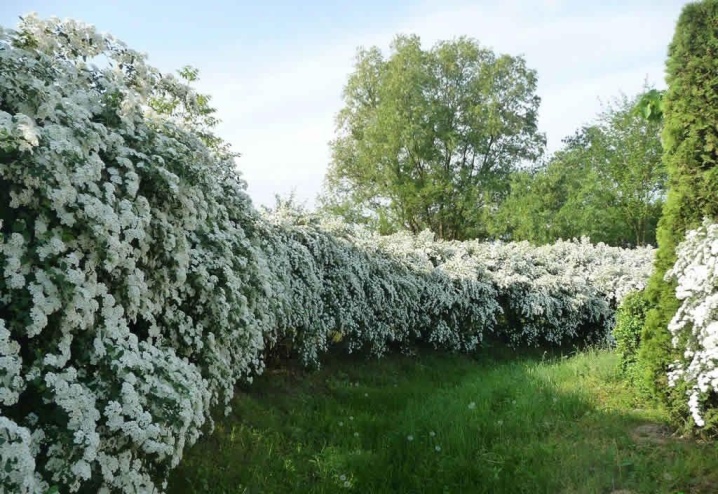
Japanese spirea in a park bed.
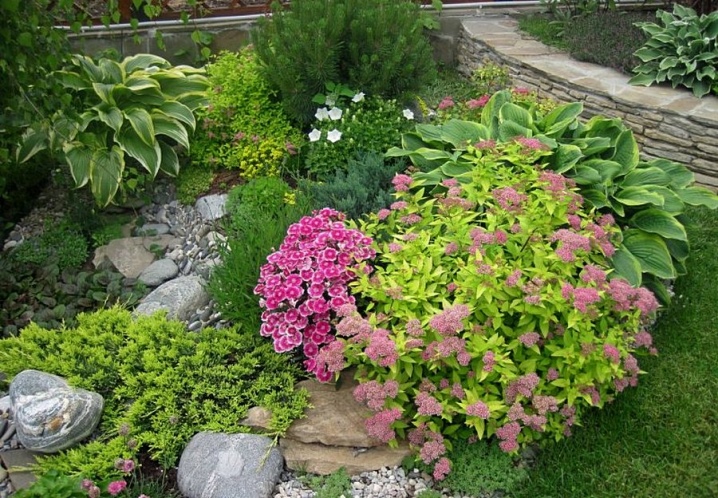
Spirea as a soil-strengthening plant.
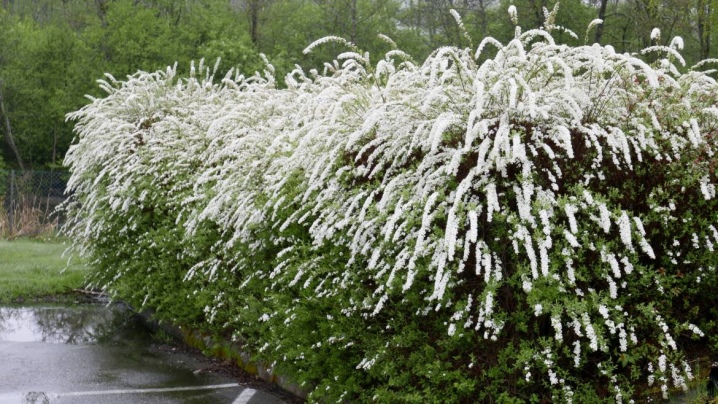
You can learn more about spirea in the following video.

































































The comment was sent successfully.